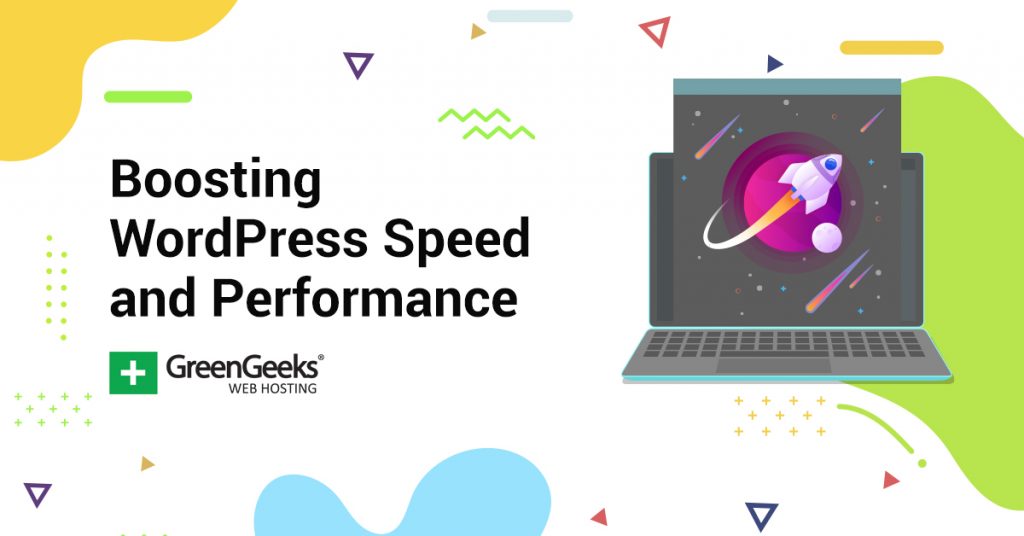The speed at which your WordPress website loads is arguably one of the most important factors when building a successful website. Not only does it improve conversion rates, which leads to more sales, but Google and other search engines use site speed as one of its ranking signals in its search results.
What does this mean?
If your site is slow, you’re going to lose out on making more money with your business.
In this guide, we will go through everything you need to know about speeding up your WordPress website so that your visitors have a great experience with your business.
Why is the speed of your WordPress Site Important?
Speed is important for a variety of reasons, but the three most important include the visitor experience, search engines, and conversion rates.
Let’s take a look at each one.
Visitor Experience
Waiting for a page to load is the bane of many. This is one statement that everyone can agree with, especially when so many websites exist that can load a page in under a second. According to Google, 53% of visitors will leave the page if load times exceed 3 seconds.
What’s even worse than a long load time? If the page is sluggish and fails to load properly because of poor design choices. It’s a surefire way to guarantee a visitor will never come back.
Search Engines
If there’s one thing that every search engine has made clear, website speed is a factor they consider when ranking your site. Search engines are designed to help users find websites that provide the information they want without taking too long to get it.
And as we just discussed, speed can drastically alter that experience. Thus, it has become a top priority for search engines to prioritize rankings for faster sites.
Conversion Rates
According to Google, a 0.1-second improvement can increase conversion rates by 8.4% for retail sites. Every millisecond counts when a shopper is considering making a purchase.
Speed is more important to online stores than any other website type.
It also implies shoppers can load more product pages, which means there is a better chance for their shopping cart to fill up. Simply put, speed improves sales.
How to Test Website Speed

Obviously, you are going to need to know how your website is performing to help you identify a problem. Luckily, there are a variety of tools available to use in WordPress that can do this.
Google PageSpeed Insights
Google PageSpeed Insights is a powerful tool that will help you identify major flaws that are impacting your load times. In fact, this is the best place to start when trying to figure out where you can improve.
It provides a score and highlights problem areas on your website. The most common ones being minifying CSS, JS, and HTML. That said, the tool actually doesn’t clearly tell you a specific speed.
GTMetrix
GTMetrix is a free optimization plugin that you can run from within your website. It shows two separate scores, one from the previously mentioned Google PageSpeed Insights, and the other being YSlow, a metric used by GTMetrix to analyze mobile performance.
Getting two points of reference without having to leave your website is a great option. It lets you compare the data to find problem areas and what you can do to fix them.
WebPageTest
WebPageTest is another excellent free page speed tool you can utilize. It provides a detailed report of what factors are influencing your speeds. It also provides separate scores for security, first-byte time, and other factors.
And yes, this tool does actually tell you the exact time it takes a page down to the millisecond, so it’s quite handy.
How to Speed a WordPress Site

Choose Fast WordPress Hosting
The web hosting company you choose matters and will greatly influence the speed of your WordPress website. And to say that the web hosting industry is competitive is an understatement. In reality, you have a lot of companies to choose from, but at the same time, not really.
All of these companies are not alike, and while you may see advertisements that have competitive prices and features, the speeds are anything but equal. That’s why at GreenGeeks we actually specifically designed our WordPress hosting plans with speed in mind.
Our hosting platform is optimized to ensure that not only can we provide the best eco-friendly web hosting in the world, but we also have some of the fastest WordPress hosting as well.
GreenGeeks web hosting consistently ranks as a Top Tier for WordPress Hosting Benchmarks.
Optimize Media Files
Images and videos are a big part of every website and sadly, there is one downside to them. They are big files and they can impact the load times of your website. However, this is completely avoidable by optimizing the file sizes.
For images, the average file size should be somewhere around 150kb at most. You can further shrink an image file by using a compression tool. In the case of videos in WordPress, the trick is to never host the videos yourself.
Instead, you should host them on YouTube and embed the video on your website. This saves server resources and improves page loading speed, especially if you use tools like WP Rocket’s Lazy Load to add YouTube placeholder thumbnails instead of the actual JS embedded script.
Use A Lightweight Theme
Many beginners believe that themes simply allow you to choose the appearance of your website in WordPress. However, that is only partially true. They have many features that also dictate how your website behaves, which can impact load times.
When selecting a theme, the keyword you need to search for is “lightweight.” This signifies that the theme was built with speed in mind. Most of these themes offer a minimalist design approach, which just means your content is the main focus.
Minimalist themes are an excellent choice for websites with great images because they become the focus of attention.
Don’t Use A Lot of Plugins
Plugins are great and can add a variety of features that are necessary to keep your website working correctly. However, there is such a thing as too many plugins. Each plugin uses a small number of resources, which means each one slows down your website.
In many cases, the effects will be negligible. Yet in other cases, like security plugins, they can be noticeable. That’s why you should only ever install a plugin that you need. It’s also important to understand that some plugins are better than others.
Reading reviews and using a testing environment is vital when trying to optimize WordPress for speed.
Use Responsive Design
Everyone understands that mobile users make up a large percentage of traffic on the internet. In fact, in the United States, 61% of all traffic came from mobile devices. This is exactly why Google uses the mobile version of your website to decide rankings.
And while mobile devices have become incredibly powerful over the years, they are still miles away from a desktop’s power. This means that the images need to be properly sized for the screen, and in some cases, certain features may be absent from the mobile site.
The good news is that almost everything is mobile-friendly nowadays, but you need to make sure those features are active.
Use A Caching Plugin
Caching is an extremely important process that allows your website to make a copy of static pages to display to visitors. This means that instead of loading a page from scratch, the website already knows what to display.
To accomplish this in WordPress, you are going to need a caching plugin, and luckily there is no shortage to choose from. In fact, I recommend every website has a caching, security, and backup plugin set up from the get-go.
These are essential tools and help boost speed, security, and recovery.
Utilize Lazy Loading
Lazy loading is a development technique in which elements of a page are not loaded until they are necessary. Or to put it simply, your web pages will only load page elements when they are visible. This can dramatically improve load times in most cases.
For WordPress, the most common use for this technique is for images. We already discussed that images should be optimized, and lazy loading takes it a step further. Let’s face it, many visitors that click on a page do not scroll down.
Thus, there’s no reason to load those images unless the visitor does explore the page. It’s highly effective and simple to implement.
Use Pagination in the Comment Section
The comment section is an important part of any community as it allows direct communication with readers. However, as the number of comments begins to increase, loading all of them can be a challenge. Especially when that number enters the hundreds.
To prevent comments from slowing down your pages, you need to use pagination in the comment section. This simply displays a set amount of comments at one time and visitors must select the page to read those comments.
WordPress has this feature built-in and it takes less than a minute to set up.
Minify CSS, JS, and HTML
One of the main advantages of using WordPress is that you don’t have to write a single line of code. However, there are plenty of cases that your website can benefit from doing so.
Yet, every time a CSS, JS, or HTML call occurs, it slows down your website.
Thus, to speed up WordPress, you need to minify these files and reduce the number of calls. One of the best and easiest ways to do this is to use the Autoptimize plugin. It minifies all of the code and ultimately makes it lightweight.
In fact, Autoptimize effectively reduces the Cumulative Layout Shift score in PageSpeed Insights and GTmetrix.
Some plugins might even add custom code without your knowledge, thus this plugin will help identify and minify it.
Turn Off Pingbacks and Trackbacks
Pingbacks and trackbacks are alerts that WordPress produces whenever your website is used as a link on another website. In theory, this is a useful notification.
However, the reality of the situation is that you will mostly receive a ton of spam.
In fact, I wouldn’t be surprised if you have already disabled pingbacks and trackbacks in WordPress due to never-ending backlinks. Not only are these requests annoying, but receiving hundreds daily will slow down your website.
As your website grows, disabling this feature is a necessity to speed up WordPress.
Disable and Delete Revisions
Every website needs to update content and keep it relevant. To do this, you need to go back and edit the post or page. This should happen regularly. However, one thing beginners don’t understand is that WordPress saves the old version as a revision.
This will help you revert to the old content if necessary and can be quite handy. It also can add hundreds if not thousands of lines to your database, which will affect your overall speed. Thus, it is in your best interest to delete existing revisions and disable the feature entirely.
And just in case you like this feature, you could also try limiting the feature by restricting the number of revisions stored.
Limit Social Sharing Buttons
Social media has taken the world by storm and has permanently changed how websites and businesses market themselves. Nowadays, everyone has a social media presence and that means you have a way to integrate your website with that platform.
Enter social sharing buttons.
However, there is one problem…they slow down your website. Yet, simply removing all of them isn’t a good option. Instead, the best choice is to limit the number of buttons you include.
Even the biggest companies only list a few social sharing buttons, so don’t go overboard and watch out for redundancy in this area.
Use GZIP Compression
GZIP compression uses an advanced compression algorithm to compress common WordPress files (HTML, CSS, JS, etc.). When a request is made by a user, instead of these larger files being used, the compressed version is.
This feature is highly recommended by Google PageSpeed Insights because it can potentially decrease file sizes by 70%!
If you’re using GreenGeeks as your WordPress hosting provider, your WordPress install is set up by default with LiteSpeed Cache, helping you speed up WordPress natively.
You can even go further and easily enable the optimizations mentioned above with LiteSpeed Cache.
Speed Up WordPress Today
Maximizing your website’s speed improves the user experience and helps you climb search engine rankings. There is no downside to having a fast website, but it does require some effort to achieve.
By following the above tips and advice from page speed tools, you can create a great experience for users and search engines alike.
If you haven’t started building your website, be sure to check out our step-by-step guide to do it in 2022.
Which tips had the biggest impact on your website? What is your favorite page speed tool to use?


very useful tips on how to increase wordpress speed, thank you!
You’re welcome